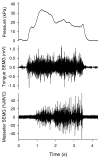The effect of jaw position on measures of tongue strength and endurance
- PMID: 15212570
- PMCID: PMC3523665
- DOI: 10.1044/1092-4388(2004/045)
The effect of jaw position on measures of tongue strength and endurance
Abstract
Assessment of tongue strength and endurance is common in research and clinical contexts. It is unclear whether the results reveal discrete function by the tongue or combined abilities of the tongue and jaw. One way to isolate the movement of the tongue is to constrain the jaw kinematically by using a bite block. In this study, 10 neurologically normal young adults performed tongue strength and endurance tasks without a bite block ("jaw-free") and with bite blocks of various heights (2, 5, 10, and 15 mm for strength; 5 mm for endurance). Data signals included tongue pressure exerted on an air-filled bulb, surface electromyography (SEMG) from the superior tongue blade, and SEMG from 1 masseter. On average, tongue strength (pressure in kPa) was greatest with no bite block and generally decreased as bite blocks increased in height. Pairwise analyses revealed statistically significant differences for all but 3 comparisons (jaw-free to 2 mm, 2 to 5 mm, and 5 to 10 mm). After removing outlying data from 1 participant, tongue endurance at 50% of tongue strength was significantly greater without a bite block than with one. SEMG data did not differ significantly for the strength task across bite block conditions, but inspection of the individual data revealed a tendency for masseter activity to be lower when the jaw was unconstrained. These results suggest that maximal tongue strength and endurance are best assessed with an unconstrained mandible or with a very small bite block.
Figures




References
-
- Abbink JH, van der Bilt A, Bosman F, van der Glas HW. A comparison of jaw-opener and jaw-closer muscle activity in humans to overcome an external force counteracting jaw movement. Experimental Brain Research. 1998;118:269–278. - PubMed
-
- Bahr DC. Oral motor assessment and treatment: Ages and stages. Boston: Allyn and Bacon; 2001.
-
- Baragar FA, Osborn JW. A model relating patterns of human jaw movement to biomechanical constraints. Journal of Biomechanics. 1984;17:757–767. - PubMed
-
- Blanksma NG, van Eijden TM. Electromyographic heterogeneity in the human temporalis and masseter muscles during static biting, open/close excursions, and chewing. Journal of Dental Research. 1995;74:1318–1327. - PubMed
-
- Doble EA, Leiter JC, Knuth SL, Daubenspeck JA, Bartlett D. A noninvasive intraoral electromyographic electrode for genioglossus muscle. Journal of Applied Physiology. 1985;58:1378–1382. - PubMed
Publication types
MeSH terms
Grants and funding
LinkOut - more resources
Full Text Sources
Other Literature Sources

